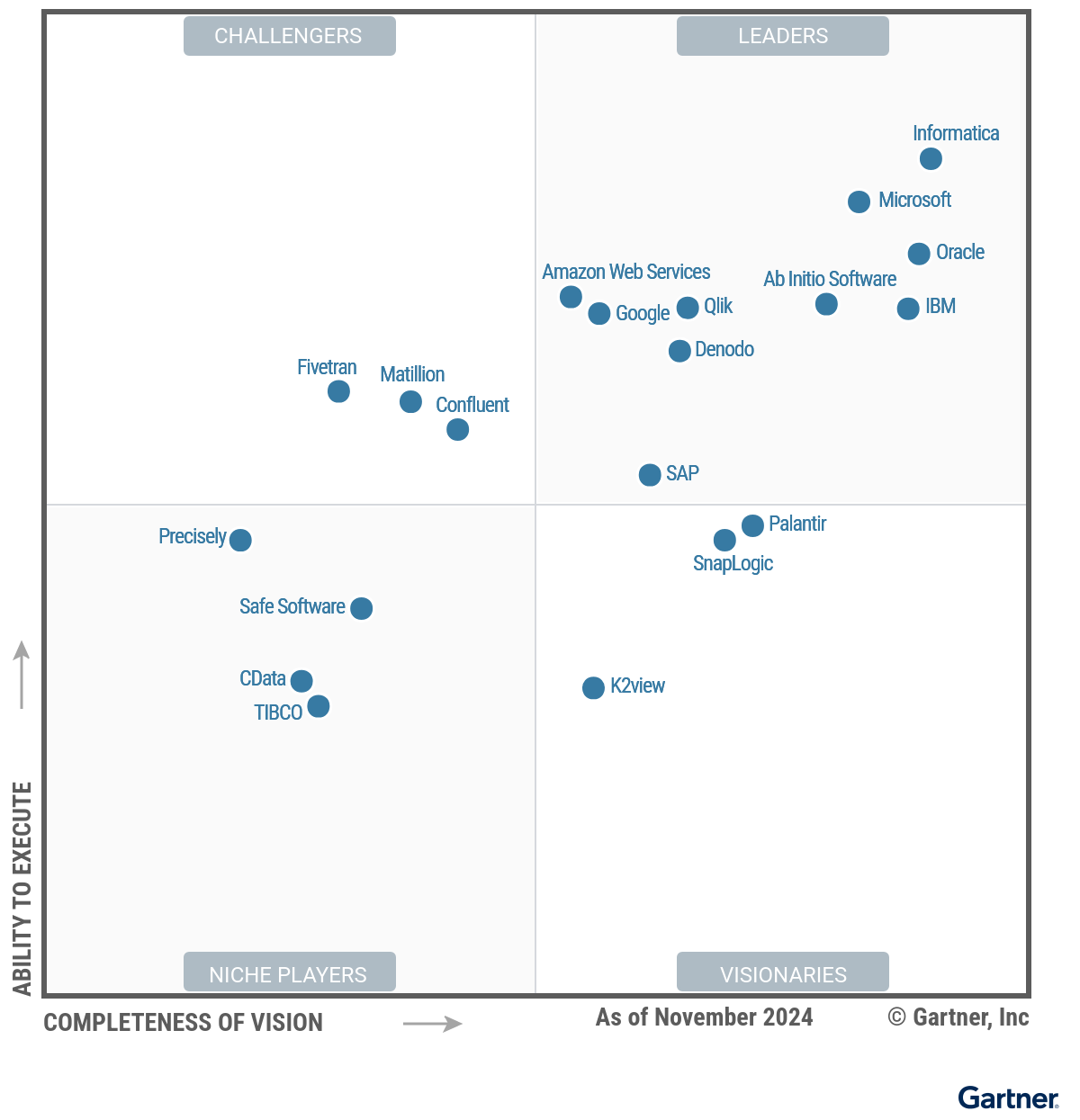Oracle has once again, been named a Leader in the 2024 Gartner® Magic Quadrant™ for Data Integration Tools. This year, Gartner called out the importance of data in AI workflows and experiences. Their Strategic Planning Assumption stated that by 2027, AI assistants and AI-enhanced workflows incorporated into data integration tools will reduce manual intervention by 60% and enable self-service data management.

Gartner complements their Magic Quadrant with a detailed analysis of the critical capabilities of each vendor’s solution in their 2024 Gartner® Critical Capabilities for Data Integration Tools. Gartner ranks Oracle 1st in Operational Data Integration and 2nd in Data Engineering Use Cases.
“We are honored to again be named a Leader in the 2024 Gartner Magic Quadrant for Data Integration Tools. It’s now been sixteen consecutive years,” said Jeff Pollock, Vice President Product Management, Oracle. “We thank our customers for their partnership and collaboration. Over the past two decades, Oracle has continuously invested in an expanding our comprehensive portfolio of data integration solutions that enable customers to dynamically connect data and automate data delivery across their hybrid and multicloud data fabric.
A key reason for our product success is our unified development, operations, and support strategy across engineering teams spanning Oracle Cloud Infrastructure, Oracle Database, Oracle GoldenGate, Oracle Analytics, and Oracle Data Integration. Our latest cloud deployments, appeal to both our large legacy install base and our newest cloud-only customers. We look forward to many more years helping our customers achieve more with their data and investing in market-leading innovations.”
Gartner characterizes the data integration tools market into four operational and analytical uses that most enterprises face today.
- Operational Data integration — Use cases such as consolidation of master data, delivering and using data hubs, interenterprise and partner data sharing, and application integration
- Data Engineering — Data integration by technical user personas to develop, manage and optimize data pipelines in analytical use cases
- Modern Data Management Architectures — Enable modern data management design patterns such as lakehouse, data fabric, data mesh and deliverables like data products
- Less-technical Data integration — Enable less-technical user personas for various analytical demands of data, such as analytics and business intelligence (ABI), and data science use cases
The Oracle Integration products and services portfolio is a comprehensive and integrated collection of data and application integration capabilities across all of these areas. Oracle remains committed to enhancements to its OCI-based and on-premises data integration products, with clear product roadmaps for both.
To catchup on the entire ecosystem of evolving connectivity visit our websites: Oracle GoldenGate, OCI GoldenGate, OCI GoldenGate with the new embedded ETL/Data Transforms, Oracle Data Integrator, Oracle Autonomous Data Studio, and Application adapters using OCI Data Integration. Be sure to visit the GoldenGate YouTube channel for video education, demos, and testimonials, and Oracle LiveLabs to get hands on.
Those at the leading edge of real-time business operations, engagement, and analytics are seeking faster-than-ever operational and analytical data integration across their legacy and multicloud data stores. Real-time connections are the foundation of real-time experiences and the necessary foundation for trusted generative AI and large language models. For more thoughts about transforming your data estate into a highly responsive data mesh, read the Oracle Data Mesh ebook and the Oracle Data Mesh for Retail industry ebook.
Read the Gartner, Magic Quadrant for Data Integration Tools, 2024.
Read the Gartner Critical Capabilities for Data Integration Tools, 2024. (link coming soon)
Gartner is a registered trademark and service mark, and Magic Quadrant is a registered trademark of Gartner, Inc. and/or its affiliates in the U.S. and internationally and are used herein with permission. All rights reserved.
Gartner does not endorse any vendor, product or service depicted in its research publications, and does not advise technology users to select only those vendors with the highest ratings or other designation. Gartner research publications consist of the opinions of Gartner’s research organization and should not be construed as statements of fact. Gartner disclaims all warranties, express or implied, with respect to this research, including any warranties of merchantability or fitness for a particular purpose.
Gartner, Magic Quadrant for Data Integration Tools, by Thornton Craig, Sharat Menon, Robert Thanaraj, Michele Launi, Nina Showell, 3 December 2024.
Gartner, Critical Capabilities for Data Integration Tools, by Michele Launi, Thornton Craig, Sharat Menon, Robert Thanaraj, Nina Showell, 3 December 2024.
This graphic was published by Gartner, Inc. as part of a larger research document and should be evaluated in the context of the entire document. The Gartner document is available upon request from Oracle.
